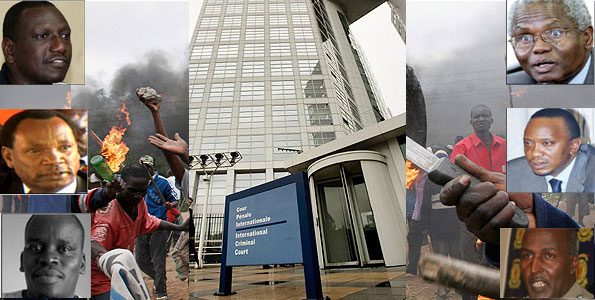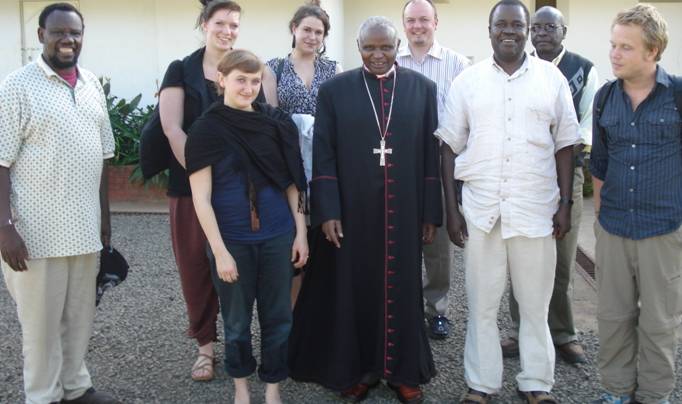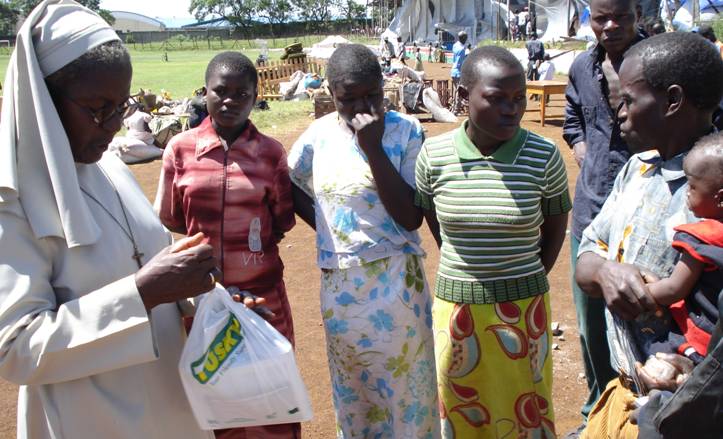
Forensic investigations
The aim was to investigate post election violence related deaths-an investigative report by the Independent Medico-Legal Unit (IMLU) on February 24, 2008. The violence took the form of killings, rape, and arson acts, forceful evictions and internal displacement. It is estimated that over 1,000 people have been killed, over 400,000 internally displaced/ forcefully evicted, women and girls raped and property worth millions destroyed.

Suspended minister William Ruto, ODM chairman Henry Kosgey, radio presenter Joshua Sang, Head of Civil boss Francis Muthaura, Deputy Prime Minister Uhuru Kenyatta and Postmaster-General Hussein Ali have been ordered to The Hague over their alleged role in the post-election violence/ File.
This report is a compilation of the findings of the post-mortem examinations carried out on sampled cases in key violent spots nationwide. It includes a comprehensive review of the autopsy findings and medico-legal inferences and opinions.
Independent Medico-Legal Unit (IMLU) is a registered non-governmental organization that seeks to promote the rights of torture victims and protect Kenyans from all forms of state perpetrated torture.
Eighty post-mortem examinations were carried out in public mortuaries in Nakuru, Molo, Kericho, Kisumu, Eldoret, Webuye, Bungoma Mumias and Nairobi. The ages of the victims ranged between 12 years and 84years. Out of the 80 post mortem examinations, 10 percent were carried out on minors, 50 percent on person’s aged 12-40. Elderly persons, above 60 years of age, contributed to 9 percent of our sample.
Of the 80 post-mortems conducted, only two victims were female. And regrettably, one was a 12-year-old schoolgirl from Kondele area of Kisumu. 43 percent of the examined bodies had gunshot injuries to various parts, including the head, abdomen and chest.
The remaining 57 percent showed various injuries inflicted by assorted crude weapons. These resulted in arrow wounds, cut wounds; blunt objects trauma, stab wounds, amputations, decapitations and even burns.
Of the 40 post-mortem examinations conducted in various towns in the Rift
Valley, only 8 had gunshot wounds. Thus 20 percent of the victims whose deaths were documented in Rift Valley had suffered from gunshot injuries and 80 percent from crude weapons.
Nairobi revealed a mixed picture, with 38 percent having gunshots and the remaining 62 percent having sharp and blunt force injuries. All the 8 cases (100 percent) sampled in Kisumu had gun shot wounds. Of the post-mortems from western province the case of death was attributed to gunshot injuries was 91 percent while 9 percent related to death caused by crude weapons.
In 29 percent of the cases, family members alleged that the police shot the victims.
This was the case where eyewitnesses were available to offer corroborative statements. For the remaining (14 percent) of victims of gunshots, the families had no information on the circumstances of death and no witnesses had been forthcoming with this category falling amongst the unknown perpetrators.
63 percent of cases were killed by unknown people, under either known or unknown circumstances. 9 percent of cases had been clearly witnessed as having been occasioned by mobs wielding machetes and other crude weapons such as wooden clubs, metal rods, bows and arrows, etc.
Bishop Cornelius Korir of Eldoret Catholic Diocese
Amani mashinani (Peace at the grassroots)-this is a booklet by Bishop Korir focusing on experiences of Community Peacebuilding in the North Rift Region of Kenya published in 2009 by the Catholic Diocese of Eldoret, Kenya by Catholic Relief Services and Caritas Australia, funded by AusAID- Printed in Nairobi by The Seed Studio.

People for Peace in Africa Director, Mr Joseph Ngala (left), Advocacy and networking head, Fr Joachim Omolo Ouko, AJ (second right)-led the Norwegian Peace delegates to pay courtesy visit to Bishop Korir (centre) in Eldoret last year/ File
The book clearly outlines a detailed process of building peace at the local, grassroots level, based on firsthand experience. The information presented here is very useful to the various people and institutions involved in Peacebuilding, including government, NGOs, civil society, religious organizations and other developmental partners.

Maryknoll priest, Fr Joseph Healey (left) with Kiambu children shortly after the violence-he was talking to them the goodness of staying united as Kenyans and how to forgive and reunite, Photo by Fr Joachim Omolo Ouko, AJ
The book begins by expressing how one woman, named Esther, in Cheptiret hosted displaced people in her home and tried to dissuade the youth from harming them. She was among those who participated in the first Peacebuilding initiative in her area.
Several parish churches provided sanctuary and relief to the displaced, including Sacred Heart Cathedral, Kapsoya, Majengo, Huruma, Burnt Forest,Timboroa, Turbo, Moiben and others. Two priests in particular took enormous risks to end the violence- Father Noel Mutangaya of Timboroa.

People for Peace in Africa-Western region, Sister Joseph Bunde (left) praying with the victims of the violence in Kisumu Stadium in February 2008-most people lost their properties during the violence/ Photo by Fr Joachim Omolo Ouko, AJ
Parish started local Peacebuilding processes without waiting for external intervention, drawing on his involvement in Kerio Valley peace projects in the 1990s. Father Charles Kirui of Burnt Forest Parish contributed tremendously. It was difficult for him at first, being a Kalenjin, when hundreds of displaced Kikuyus sought refuge at his church. He managed to build confidence, provide relief assistance and initiated the local peace process. Burnt Forest was one of the worst hit places in Eldoret.
Aid agency partners such as the US Agency for International Development, the Red Cross and Concern Worldwide supported the initiative wholeheartedly. There was also local support and donations from various people and institutions. For instance, one student of Moi University sacrificed Kshs.3,000 to support the relief effort – it was a moving, humbling and generous gesture.
Alphax College also donated the first food to the displaced people camping at the Cathedral. Other religious organizations that supported the initiative included Brothers of Mercy (CMM Brothers), Association of Sisterhoods of Kenya, Catholic Diocese of Lodwar, Anglican Church of Kenya, Reformed Church of East Africa and the National Council of Churches of Kenya.
Many religious groups provided counseling services to victims of violence, softening their hearts and opening a way for dialogue. Rev. Lelei of the Anglican Church in particular administered in Lelmolok, Kesses Division in Eldoret South District, one of the hotspots of the violence.
Several government officials also supported, including the District Officer and Chiefs in Kesses who attended the first peace meetings at the Cathedral. They helped in mobilizing Kalenjin people from their areas to attend the gatherings. The Chief in Timboroa, Mr. Kendagor, supported with great zeal the Church’s peace initiative there.
It all started in 1997 and Eldoret Diocese was engulfed in the ferocious turmoil surrounding the second multiparty elections after many years of dictatorial single party rule. Political authorities were sowing seeds of discord, dividing citizens along tribal lines and instigating terrible communal violence.
At the same time, battles between Pokot and Marakwet warriors, instigated by cattle rustling, raged in the Kerio Valley. Fearing for their safety, Bishop Korir went to visit some of the Sisters and priests in the parishes. As he visited three Sisters in Endo, he saw houses burning all around.
On his way back to Eldoret, he decided to take tea at the parish house in Chesongoch. All of a sudden, a shoot-out broke out between Pokot and Marakwet gunmen. The priest and the bishop took cover in the corner and the Sisters ran to hide. They sat there for two hours, just listening to the different types of guns. When the fighting finally died down, they found many dead people lying on the ground and numerous others injured. They provided first aid and helped take casualties to the hospital.
Later they returned safely to Eldoret, but Pokot warriors shot at the car of the District Commissioner some few minutes behind the bishop on the road. Afterward, one of the Pokot commanders told the Sisters that they had discussed whether to shoot at Bishop Koriri’s vehicle. The warriors had wanted to, but had eventually decided against it, because he was a Bishop and because the Diocese had provided their villages with food during a recent famine.
Bishops Koriri began to realize the church, and his Diocese, could play a special role in calling for peace in their valley. They realized that the church needed to exercise ‘stewardship’ in the community ‘by resolving to work with the people to achieve sustainable peace.
There are several steps used, including step 5 in which food is shared among the conflicting communities. In many African traditions and cultures when former enemies ate together it symbolized reconciliation and healing. Sharing a meal cemented an agreement to be peaceful to one another.
Step 6 involves intra-ethnic meetings before bringing larger groups together, the communities we found it helpful for the conflicting groups to meet separately to clarify their grievances or the wrongs they want righted.
People
for Peace in Africa
(PPA)
P O Box 14877
Nairobi
00800, Westlands
Kenya
Tel
+254-7350-14559/+254-722-623-
E-mail- ppa@africaonline.co.ke
Website: www.peopleforpeaceafrica.org